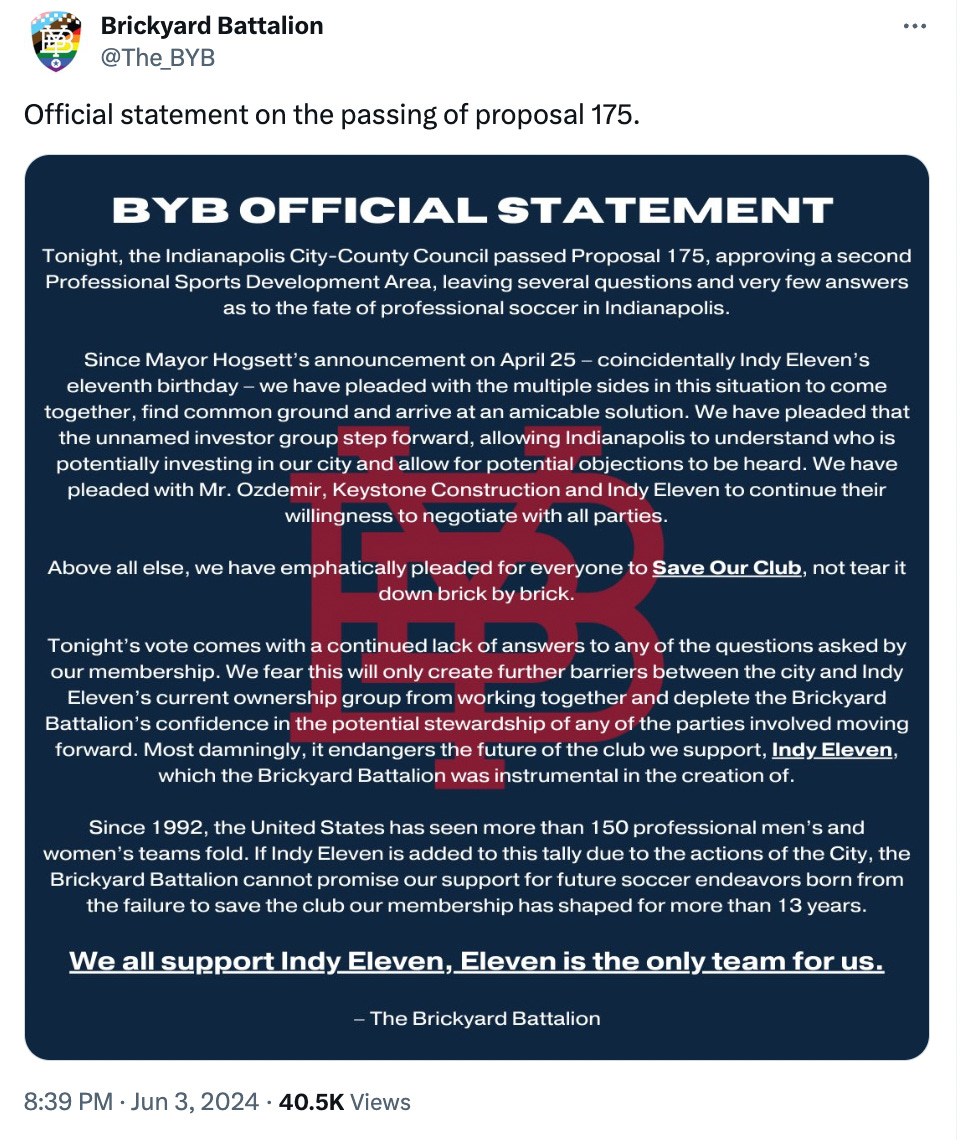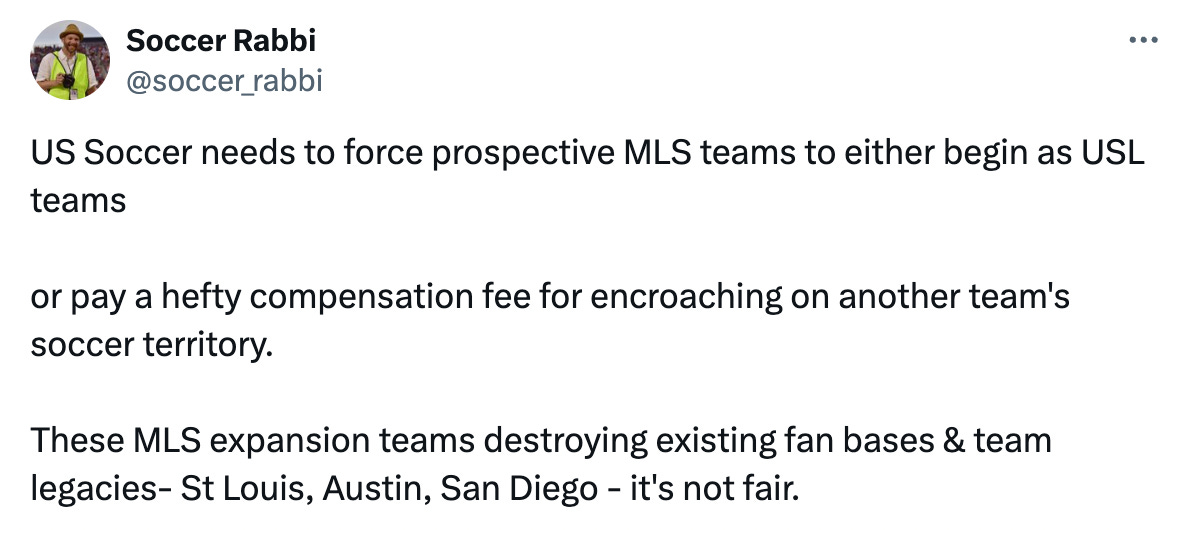Backpass: The MLS and USL Turf War heats up
As MLS continues to expand, it seems to care less and less about how that affects the second division league, USL. And that's probably bad for American soccer.
Last week when scrolling through X – which I have been doing less of in the past year1 – I came across this disappointing announcement from the supporters group of Indy Eleven, the USL team in Indianapolis.
TL;DR, it seems like plans for MLS to expand into Indianapolis are ramping up. This is good for Indianapolis, who have proven to be a strong soccer market since Indy Eleven’s formation in 2013. However, the way it is going down isn’t good for American soccer or MLS, and is just the latest salvo in the war between MLS and USL, the top two tiers of American soccer. This war is also not good for American soccer.
MLS has been undermining USL for several years now. The first major friction point was MLS’ creation of MLS Next Pro, a quasi-reserve/academy league that effectively removed all MLS clubs collaborations with USL clubs for player development. There are good reasons for MLS to have made that move: it’s hard to trust a USL head coach with giving youngsters playing time when you send them on loan to their team. The Rapids experience with Colorado Springs Switchbacks demonstrated this, as many Rapids academy players seemed to languish rather than flourish.
At the start of 2024, MLS did further harm to USL in the leagues selfish and unpopular decision that all MLS clubs would not be appearing in the 2024 edition of the Lamar Hunt US Open Cup, the oldest soccer competition in the United States. Don Garber, MLS Commissioner, relented somewhat by leaving the defending champions, Houston, and seven other MLS clubs in the competition.2 All other MLS teams would send their MLS Next Pro Team. Rapids 2 played one match against the Switchbacks (and, Rapids Jason would like it noted, played one match against Azteca that they won 3-0), and that’s why USOC has occupied zero lines of RAM in your brain this past year. That, and the fact that it is both poorly promoted and incredibly hard to find streaming or on TV. All of that is a shame, because it’s a really fun event.
But the most aggressive and harmful act of MLS towards USL, and in turn American soccer at large, is MLS’ expansion into markets with an existing USL team. In these instances, most recently with Miami, San Diego, and St Louis, Major League Soccer chose to create a brand new team, and chose not to promote the existing USL to the first division. The new MLS owners in these examples simply paid the expansion fee, created a new club, ploped down in a city with an existing USL club, and pretended they invented the game. It’s bullshit.
They did it in 2023 when the league announced an expansion club in San Diego with an Egyptian billionaire owner, Mohamed Mansour. Rather than acquire San Diego Loyal, the existing USL club, Mansour simply paid the $350 million expansion fee and began building a club. The Loyal, seeing the inevitability of their fan base drying up, announced they were folding. To be fair, they hadn’t been around that long, but there was still a group of fans that invested their time and energy into SD Loyal, and all that energy was now for nothing.
They did it in 2019 when MLS expanded in St Louis. Again, the St Louis MLS ownership group ignored the existing St Louis USL franchise, St Louis FC. The USL version was founded in 2014, and folded in 2020, because they knew that competing in a medium-sized midwestern city for eyeballs with an MLS team was untenable.
MLS also expanded over the past decade into Charlotte, Miami, and Austin3. In each of those expansions, a USL team was pushed aside in the creation of the MLS team. Charlotte is still in existence in USL League One. Miami FC still exist in the USL’s top division of USL Championship. However, as of June 16, they are dead-last in the league in attendance, averaging just 1,044 fans per match.4
This kind of encroachment into the territory of another soccer team is harmful to local soccer fans, and unfair to owners in USL towns that have invested time and energy building a brand and a fanbase only for an MLS owner to swoop in and take it all for themselves.
In the past, soccer franchise owners have also done it the other way, or what I would call ‘the right way’. There have been many instances of a USL team and owner paying the MLS expansion fee to ‘gain promotion’ to MLS. Orlando (in 2015), Minnesota (2017) Cincinnati (2019), and Nashville (2020) started out in USL (or in MNUFC’s case, NASL) and took an existing team with history and branding and – *most importantly*, FANS, and brought them from the second division into the first. This is the normal, logical way to do things: start with a small team in a lower league, prove your concept, grow your fanbase, and when you are ready, jump to MLS.
On some level, this is sort-of how every other soccer system on the planet works. Except that, of course, in other leagues, promotion and relegation from lower leagues to higher leagues is achieved through on-the-field competition. In the US, once a team proves they turn a profit and fill out the stands, it then demonstrates that they could move up to MLS and be successful there.
But instead, the USL teams that test the waters and then demonstrate success are not being rewarded for the risks they’ve taken. They’re being destroyed as other carpetbagging owners sweep in to snake the potential profits.
Indy Eleven have drawn an average of 9,529 fans this season, and they drew 9,709 a game in 2023 - putting them in fourth and third, respectively, in USL for attendance. Certainly the new MLS ownership group knew this when they decided to invest in that market.
One could argue ‘whelp, that’s capitalism.’ If I want to start a hamburger stand across from a McDonalds and put them out of business, that’s my right. And to some degree, I agree. I’m not crying a river for the owners of these USL franchises. They created a business. They generated income. They had the chance to put together their own ownership groups for MLS if they wanted, or to sell their branding and properties to the eventual MLS team if it had worth. That didn’t happen.
Still , I do think those owners are being hard done. And I do think there’s something unseemly about US Soccer just allowing teams to move into existing markets without any regulation. That’s actually not the way it generally works in American business - that you can’t profit from another’s work without compensating them, or encroach on another business.
Major League Baseball actually tightly controls which teams can go where. The Oakland A’s were prevented from relocating to Fremont, California because the league had long ago decided that was San Francisco’s territory. Teams desiring to relocate must pass a vote by all the other owners. It’s not just ‘whatever the market will bear.’
Recently there have been lawsuits around AI’s use of the art and writing of individuals who did not consent to their work being sampled or used. The idea is the same, to some degree, as an MLS benefitting from the work USL did in establishing and growing the soccer audience in a market.
I mostly see this as an issue of fairness: if Major League Soccer is going to expand, and a USL team exists in the market they are expanding to, then either the USL team should become the MLS team, or some kind of compensation should be paid for the years of development the team has invested. San Diego Loyal and Austin Bold weren’t around long before MLS moved in; the payment should be small. Indianapolis has played for a decade, and has a strong base of fans who will move right on over to the MLS team when it happens; either MLS should work with the Indy ownership towards ‘promotion’ or the owners should be compensated.
I see this also as a rising trend. Since Orlando, Cincinnati, and Nashville were promoted, the league has gone the other direction towards encroachment and replacement. With the league expanding to 30 teams next season, logic dictates that they will seek a nice even number for their next resting place5, and that number will be 32 teams. If the league expands to Phoenix, Las Vegas, Detroit, San Antonio, or Louisville,6 attention should be paid to giving the local USL team either a shot at promotion or compensation for the groundwork they’ve laid. It’s only fair.
Because Elon Musk has decided to follow the Mark Zuckerberg playbook that made Facebook into a stupid mess of annoying people tweeting EXTREME opinions and has sent me in my tired moments is scrolling Instagram, which is just clips from movies and tv shows I like, pretty women, and Fallout 4 and Minecraft vids. When your tired, my lizard brain is stupid and embarrassing.
The clubs in the 2024 USOC were Houston and the top MLS teams that did not qualify for Concacaf Champions League – meaning a bunch of mid-table teams. So was this a reward?AKA ‘you didn’t qualify for CCL, so here’s a Europa League consolation prize for you.’ Or was it a punishment? AKA ‘you guys suck and so instead of Monterrey or Mexico City you have to travel to Omaha.’ The intent behind the eight teams in the tourney basically made the whole exercise a futile and stupid gesture.
MLS also expanded into Atlanta, where a struggling NASL side known as Atlanta Silverbacks existed. There was no good reason for the Atlanta FC ownership group to acquire the Silverbacks; they didn’t own a stadium, their brand wasn’t particularly strong. they did have a cool history in American soccer and passionate fans, though.
Even though there are many good reasons for the league to stop expanding, there’s no evidence that is going to happen. With expansion fees now at $350 million, I imagine Don Garber simply cannot help himself. MLS will eventually go to 36 teams. Or 40. At that point, the league should split in two. I’ve written about this before, if you’re interested.
I live in Pittsburgh. It’d be great to have MLS here. It is not going to happen: the market isn’t big enough, and it isn’t growing at fast enough rate, and the Riverhounds current owner is “only” a low-hundred millionaire.





San Diego's expansion fee was 500m not 350m